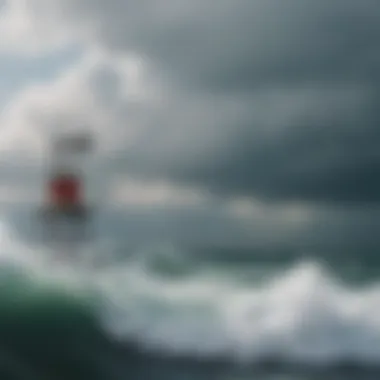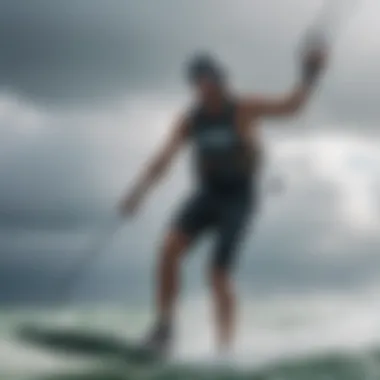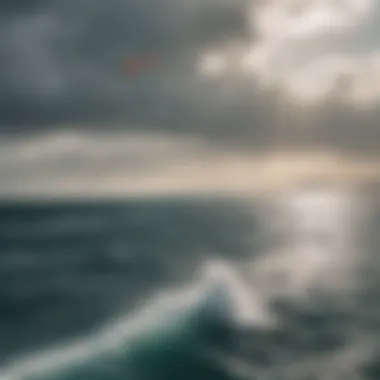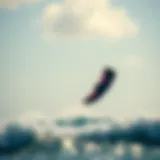Understanding Sebastian Weather Radar for Kiteboarding


Intro
Understanding how weather radars function in the context of kiteboarding can be a game-changer for enthusiasts. Kiteboarding, while thrilling, demands keen awareness of environmental conditions. In the dynamic waters of Sebastian, staying ahead of the weather can make the difference between a breathtaking session and a troublesome outing. This section serves as the starting point for unraveling the connections between radar technology, local weather patterns, and kiteboarding strategies.
The evolution of radar technology has not just gone the distance in aviation or meteorological research; it has also seeped into recreational sports, enabling kiteboarders to harness critical information about wind speeds and storm patterns. Understanding these tools can transform the way riders engage with the elements, pushing them towards safer and more enjoyable experiences.
As we venture into this guide, we will dissect the intricate dance between weather data and kiteboarding, leading the way to informed decision-making. Next, we will delve into tripods of practical knowledge that kick-off with our first section: Gear Insights, where the focus will be on essential equipment and recent gear developments tailored for both newcomers and veterans in the sport.
Overview of Sebastian Weather Radar
When it comes to enjoying kiteboarding, understanding local weather conditions can be the difference between a thrilling ride and a challenging day on the water. The Sebastian Weather Radar plays a vital role in this endeavor, providing real-time data that can help kiteboarding enthusiasts make informed decisions about when and where to go. In this section, we will explore the importance of Sebastian Weather Radar and how it accentuates the kiteboarding experience.
What is Weather Radar?
Weather radar is essentially a technology used to observe and predict meteorological conditions. Through the transmission of radio waves, this tech detects precipitation, wind patterns, and even storm systems. The data collected is presented as radar images, which are crucial for understanding weather behavior. For kiteboarders struggling to interpret the skies, the clarity offered by radar systems is a godsend. Without a doubt, it transforms guessing games into informed choices.
Understanding radar not only empowers kiteboarders but also gives instructors better tools for training their students. Imagine being able to correlate wind speed from the radar with real-time conditions on the beach. This knowledge could ensure a safer, more enjoyable experience for all involved.
The Role of Radar in Meteorology
Radar serves as one of the cornerstones of modern meteorology. It provides timely updates about rain, storms, and wind conditions that are pivotal for kiteboarding enthusiasts. The precise nature of radar helps identify not just the location of storms but also their movement.
Furthermore, radar data factors into weather models that predict future conditions. These forecasts, when combined with the instant updates provided by radar, allow kiteboarders to plan their outings strategically. Rather than blindly relying on outdated weather maps or conditions changes, these adventurers can base their decisions on live information, making their kiteboarding sessions as safe and enjoyable as possible.
"Kiteboarders using radar data make leaps in understanding weather patterns, ultimately enhancing their safety and fun on the water."
In the expansive world of weather forecasting, radar stands out as a technology that not only informs but also inspires confidence. By keeping a close eye on local radar reports, kiteboarders can ride the winds with assurance, knowing they have the best data at their fingertips.
The Technology Behind the Radar
Understanding the technology behind radar systems is crucial for kiteboarding enthusiasts keen on maximizing their experiences and safety on the water. Knowing how radar works not only helps in predicting weather changes but also empowers kiteboarders to interpret conditions in real-time. In a region like Sebastian, where wind patterns can shift quickly, being savvy about radar technology can make the difference between an exhilarating session and a sudden retreat.
Fundamental Principles of Radar Technology
Radar technology primarily operates by emitting radio waves and receiving their reflections from objects, such as raindrops or other atmospheric phenomena. The time it takes for the signals to return informs meteorologists about the distance and intensity of these objects. Here's a simplified breakdown of how it works:
- Signal Emission: A radar transmitter sends out pulses of radio waves.
- Reflection: When these waves hit an object, they bounce back to the radar system.
- Data Processing: The returning signals are analyzed to determine the object's distance, speed, and even size.
This fundamental approach is key in meteorology, allowing for the detailed mapping of precipitation and storm systems that can affect kiteboarding conditions. It’s vital to understand that not every signal that returns is indicative of rain; some might merely bounce off other objects in the air.
Understanding Radar Frequencies and Wavelengths
The effectiveness of a radar system depends significantly on its frequency and wavelength. These elements dictate how well the radar can detect different types of precipitation and atmospheric conditions. Here’s what you need to know:


- Frequency: Higher frequencies can provide more precise details about small particles, like mist or light rain. These are beneficial for kiteboarders who want to avoid sudden downpours.
- Wavelength: Longer wavelengths are better for penetrating heavier rain or large storm systems, but they may lack the fine detail that kiteboarders might also need.
Familiarizing oneself with these aspects can reveal a tremendous amount of detail about the local weather conditions. For instance, if the radar indicates significant lightweight precipitation, it's still worth checking the wind speeds because a light drizzle with high winds can be more than manageable.
Components of a Weather Radar System
A weather radar system comprises several critical components, each playing a specific role in the overall operation. Understanding these can enable kiteboarders to grasp what they’re looking at on radar images:
- Transmitter: Generates the radio waves sent out to scan for weather patterns.
- Receiver: Captures the reflected signals that return after bouncing off objects in the atmosphere.
- Signal Processor: Analyzes the data collected by the receiver, converting it into visual formats, like radar images or graphs.
- Display System: Presents the processed data in forms that end-users can interpret easily—usually on screens displaying both real-time and forecasted conditions.
Having a grasp of these components gives kiteboarders the ability to assess how accurate the data may be. For instance, a well-maintained radar system will likely provide clearer, more accurate images, thus enhancing the reliability of weather-based decisions made before heading out.
"A little knowledge goes a long way in interpreting the weather the right way—especially out on the water where the elements can change in the blink of an eye!"
Interpreting Radar Data for Kiteboarding
Understanding the nuances of radar data is a game changer for kiteboarding enthusiasts. It’s not just about catching the next breeze; it’s also about staying ahead of changing weather conditions. In kiteboarding, wind is everything. Too much or too little can turn a thrilling day into a regrettable one, possibly even dangerous. Hence, knowing how to interpret weather radar data can mean the difference between a fantastic session on the water and a risky outing.
Each radar image serves as a visual communication tool, providing essential information regarding wind patterns, precipitation, and other local weather phenomena. For kiteboarders, this means having the power to make tactical decisions based on real-time data.
Reading Radar Images: A Guide for Enthusiasts
When you glance at a radar image, there are a few vital elements to focus on:
- Color Schemes: Generally, colors represent different precipitation levels. For instance, lighter shades often indicate light rain or just clouds, while darker shades could signal heavier downpours.
- Moving Patterns: It’s crucial to pay close attention to the movement of weather systems. A storm approaching from the north might bring unpredictable gusts that could significantly impact kiteboarding conditions.
- Echoes: Areas of high reflectivity usually indicate areas of precipitation. Understanding how these echoes interact with your local geography can help you predict wind shifts and turbulence.
"Weather radar is like a crystal ball for kiteboarders; knowing how to read it gives you an upper hand in your quest for wind and waves."
To effectively read radar images, consider looking for software or applications that provide detailed overlays, which can offer insights on wind speed and direction based on current weather patterns. The more familiar you become with interpreting these images, the better you’ll catch the perfect wind.
Identifying Weather Patterns Critical for Kiteboarding
Weather patterns dictate kiteboarding conditions far beyond just the immediate vicinity of the beach. Identifying these patterns requires a bit of practice and an understanding of regional peculiarities that affect wind behavior. Here’s what to look for:
- Frontal Boundaries: Cold fronts and warm fronts can dramatically change wind direction and speed. A cold front can lift winds, making it kiteboard-friendly, while a warm front might result in lighter, less favorable winds.
- Thermal Winds: During sunny days, heating can create thermal winds which are often optimal for kiteboarding. Recognizing these patterns might mean the difference between gliding along smoothly or being stuck waiting for a burst of wind.
- Local Geography Influence: The way terrain like hills, mountains, or buildings interact with wind flows can also impact kiteboarding conditions. Knowing this localized geography can help predict sudden changes.
Once kiteboarders begin to see these patterns emerge on radar images, it becomes easier to align their outings with ideal weather conditions. Whether you are a seasoned rider or just starting, developing a keen eye for reading radar data can turn a good outing into an exceptional experience. It’s all about reading the wind and being prepared.
Local Weather Conditions and Kiteboarding Decisions
Understanding local weather conditions is crucial for kiteboarding enthusiasts. Whether you are a novice or seasoned rider, weather elements significantly influence your experience on the water. Kiteboarding relies heavily on the whims of nature, and the ability to make informed decisions based on local weather conditions can mean the difference between a thrilling ride and a hazardous outing.
Key factors like wind speed and direction, precipitation, and temperature play vital roles in shaping kiteboarding experiences. By understanding how to interpret these elements, kiteboarders can enhance their skills, reduce risks, and ultimately enjoy their time on the water to the fullest.


Wind Speed and Direction: Essential Metrics
Wind is the lifeblood of kiteboarding. Without it, your kite may as well be a colorful decoration tethered to the ground. Thus, knowing the speed and direction of the wind is paramount.
Wind Speed:
This metric is often measured in knots. Ideal wind speed for kiteboarding typically ranges from 10 to 25 knots, though this can vary based on the rider's ability and kite size.
- Light Winds (under 10 knots): May not provide enough lift, especially for beginners.
- Moderate Winds (10-20 knots): Exciting for many kiteboarders, allowing for smooth take-offs and fun tricks.
- High Winds (over 25 knots): Caution is advised; high wind can turn the sea into a turbulent playground, challenging even for experienced riders.
Wind Direction:
Knowing where the wind is coming from is just as crucial.
- Onshore Winds: These winds blow toward the land—ideal for learning and practicing.
- Offshore Winds: Coming from the land towards the sea, these can be tricky as they may push riders away from the shore.
- Crosswind: Winds coming from the side can offer a balanced experience but require good handling skills.
Precipitation and Its Impact on Kiteboarding
Rain might seem like a nuisance, particularly for those looking to enjoy a bright, sunny day at the beach. However, it is not just the amount of rain that matters, but what it signifies for kiteboarding.
- Light Drizzle: This might not stop the session, but keep an eye on wind shifts as moisture can change air density, affecting performance.
- Heavy Rain: Often associated with storms, heavy rain can signal strong winds and dangerous situations. Avoid going out if any storms are forecasted, as lightning poses a significant risk.
"It's always better to err on the side of caution. When storm clouds roll in, it’s best to pack it in."
Temperature and Safety Considerations
Temperature may not be the first thing on a kiteboarder's mind, but it can have practical consequences for safety and enjoyment.
- Warm Conditions: Perfect for prolonged sessions but be cautious of dehydration. Ensure to keep water nearby.
- Cold Weather: Riding in colder temperatures demands appropriate gear like a wetsuit; frostbite can be a real threat.
In addition, extreme temperature shifts can affect wind behavior, sometimes causing sudden changes.
Ultimately, understanding local weather conditions empowers kiteboarders to make informed decisions, keeping safety at the forefront while also elevating the kiteboarding experience. By being aware of these factors, enthusiasts can ensure they catch the perfect breeze while avoiding unfavorable weather, allowing them to concentrate on enjoying the ride.
Utilizing Sebastian Weather Radar Data
Harnessing the power of Sebastian weather radar can significantly elevate the kiteboarding experience. Understanding how to effectively utilize this data is crucial for kiteboarders aiming for the safest and most enjoyable outings on the water. The importance of grasping radar data lies not just in avoiding bad weather, but also in seizing optimal kiteboarding conditions when they arise.
Practical Applications for Kiteboarders
When it comes to kiteboarding, timing and conditions are everything. The practical applications of Sebastian weather radar extend far beyond mere curiosity about the weather. Here are some concrete uses:
- Safety First: By regularly checking the radar, kiteboarders can identify potentially dangerous storm systems or sudden changes in wind direction that could lead to risky situations on the water. Keeping an eye on these indicators can be the difference between a fun day and a dangerous one.
- Optimal Wind Conditions: The radar provides real-time updates on wind patterns, allowing enthusiasts to pinpoint the best times for wind speed and direction. For example, if radar shows that winds are steadily increasing in a certain area, that’s a signal to pack your gear and hit the beach.
- Tide Compatibility: Understanding the interaction between tide levels and wind conditions through radar data can lead to more fulfilling kiteboarding sessions. Using spotlight features on the radar to monitor simultaneous changes in tide can help in planning better launches and landings.
"For kiteboarders, it's not just about having wind; it's about having the right wind at the right time."
This knowledge not only enhances the experience but also fosters a deeper appreciation for the environment.


Incorporating Radar Data into Daily Planning
Integrating radar data into daily routines shouldn’t feel like a chore; rather, it should become second nature for regular kiteboarders. Here are some strategies for incorporating this valuable information into your kiteboarding plans:
- Morning Briefing: Start each day with a quick review of the radar data. Every kiteboarder has a routine; make accessing weather data a part of it. This sets the tone for your day and helps avoid any unpleasant surprises later.
- Set Alerts: Various weather apps and services allow users to set up alerts based on specific criteria. Consider customizing your notifications for wind speed thresholds or approaching storms.
- Engage with the Community: Platforms like Reddit or Facebook groups often share personal insights based on local radar information. Learning from fellow kiteboarders can provide additional context for weather predictions and conditions that might not be evident from radar images alone.
- Plan B Ready: Always have an alternative plan ready. If conditions shift unexpectedly, knowing your options for different locations or times can keep your day from going awry.
By embracing this approach, kiteboarders can stay informed, be proactive, and ultimately enrich their kiteboarding experiences with a seamless blend of excitement and safety.
Future Developments in Weather Radar Technology
As meteorological needs evolve, the technology supporting weather radar continues to advance. This section delves into the emerging trends and innovations that promise to enhance the accuracy and efficiency of weather forecasting, especially for activities like kiteboarding. The importance of understanding these developments sits at the intersection of technology and practical experience, enabling enthusiasts to better navigate changing weather patterns.
Emerging Trends and Innovations
The dynamic nature of weather calls for radar systems that keep pace with rapid innovations. Some key trends include:
- Dual-Polarization Technology: This allows weather radars to transmit and receive signals in both horizontal and vertical orientations. The result? A clearer and more detailed picture of precipitation, including distinguishing between raindrops and snowflakes. For kiteboarders, this means having better data to avoid unsuitable conditions.
- Phased Array Radar: Traditional radars rely on mechanical rotation, which can delay updates. Phased array systems, however, use electronically controlled radar beams. They provide quicker updates, leading to more timely and precise forecasts, essential for planning optimal kiteboarding sessions.
- Integration of Unmanned Aerial Vehicles (UAVs): Drones equipped with weather sensors can supplement data from ground-based radars. They can be deployed in real-time to gather localized weather information, giving kiteboarders an edge with important insights into conditions that might differ significantly from nearby reporting stations.
Each of these innovations carries potential benefits for kiteboarding enthusiasts. Being aware of such trends allows them to be better informed about how weather patterns can fluctuate and how best to respond.
The Role of AI in Weather Forecasting
Artificial intelligence is carving a new path for various industries, and weather forecasting is no exception. Here’s how AI is reshaping the landscape:
- Data Processing: AI can sift through massive sets of historical weather data at lightning speed. This capacity helps in recognizing patterns that humans might miss, leading to more accurate predictions. For those engaged in kiteboarding, this means a more robust understanding of frequent weather behavior in Sebastian.
- Predictive Analytics: Machine learning algorithms refine their accuracy over time, learning from new data inputs. The ability to predict sudden weather changes, or shifts in wind direction, can be invaluable while out on the water or planning a day of kiteboarding.
- Real-time Alerts: AI can enhance automated alert systems, providing real-time warnings about severe weather approaching. Kiteboarders can receive timely notifications that could be the difference between a thrilling day on the water and a harrowing one.
Additionally, the collaborative potential of AI extends to community platforms where kiteboarding enthusiasts can share live updates influenced by real-time data from weather radars. As kiteboarders embrace these advancements, their experiences will shift from relying solely on intuition to being driven by data-backed decision-making.
In summary: Keeping an eye on future developments in weather radar technology will empower kiteboarding enthusiasts with the tools to make informed decisions. With innovations on the horizon, the thrill of kiteboarding can be significantly elevated, while also ensuring participant safety.
End: Maximizing Kiteboarding Experiences
In the world of kiteboarding, understanding the nuances of local weather conditions can make all the difference between a thrilling session and a regrettable mishap. The insights gained from this exploration of the Sebastian weather radar empower kiteboarding enthusiasts to harness the wind effectively and safely. As the article has illustrated, various elements like wind speed, direction, and precipitation all play pivotal roles in determining kiteboarding feasibility and enjoyment.
Summary of Key Insights
Throughout our journey, we’ve touched on vital aspects of the Sebastian weather radar and its relevance to kiteboarding. Here’s a quick rundown of key takeaways:
- Fundamental Radar Understanding: We explored what weather radar is and how it serves as a crucial tool for meteorologists, interpreting atmospheric phenomena for our benefit.
- Kiteboarding Decisions: Knowledge about parameters such as wind and temperature not only enhances thrill but also safeguards kiteboarders from dangerous conditions.
- Practical Application: The integration of radar data into daily planning helps kiteboarders approach the sport methodically, avoiding the chaotic rush that can sometimes lead to mishaps.
- Future Technologies: With discussions on AI's role, we acknowledged the potential for forecasts becoming ever more precise, benefiting kiteboarding safety and enjoyment.
By weaving these insights into everyday practices, kiteboarders can elevate their experiences on the water, turning uncertainties into informed choices.
Final Thoughts and Recommendations
As kiteboarding enthusiasts venture into the fluid dance of wind and water, continuous learning is key. Here are a few recommendations for maximizing enjoyment:
- Stay Updated: Regularly check Sebastian weather radar before heading out. Conditions can change in a heartbeat, and being informed can save a lot of trouble.
- Develop a Routine: Incorporating radar data into pre-kiteboarding rituals can enhance decision-making. Consider creating a checklist that includes radar images, wind conditions, and weather forecasts from reliable sources.
- Practice Safety First: Always prioritize safety by assessing weather patterns before taking flight. Avoid excessive bravado when the wind starts to howl, and know when to call it a day.
- Engage with the Community: Utilize platforms like Reddit or Facebook groups to share experiences and tips with fellow kiteboarders, further deepening knowledge and safety nets.
In summary, integrating a deep understanding of the Sebastian weather radar into kiteboarding practices can lead to not just safer but also more thrilling experiences on the water. Kiteboarding is as much about enjoying the thrill as it is about respecting the elements, ensuring that every ride is exhilarating and, most importantly, safe.















